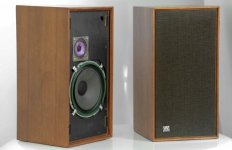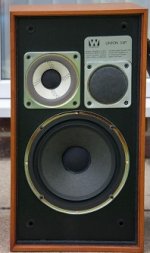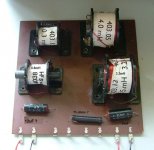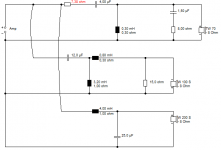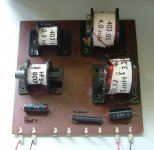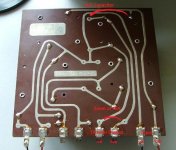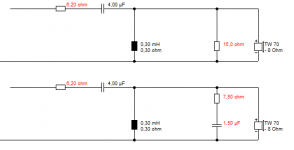system7
what is the 15 ohm reducing the tweeter power by roughly over not having it in parallel?
what is the 15 ohm reducing the tweeter power by roughly over not having it in parallel?
just a thought are the ceramic 7w wire wound resistors at maplins ok? I just noticed a site listing some audio ones that don't contain any magnetic material.
I've been a bit reticent about this thread, cypher007, because I think you made a mistake right at the start. You shouldn't have replaced a cone tweeter with a soft dome. You see THAT was what was good about those old Wharfedale Denton and Linton speakers! 🙂
Me and my GF at the time had both these 2 way speakers in the seventies, and they were terrific really. A slight weakness was the low crossing tweeters which tended to blow. Adding a midrange just makes everything even better. Enter the Linton 3XP...
Now ceramic resistors are really just fine. And you'd be pressed to hear the difference between non-polar capacitors and polypropylene. Good coils matter, as it goes, at least IMO. Here's one of mine with chunky 10W wirewounds which have insignificant inductance in practise:
If I was you, I'd see if these 92mm Monacor HT22-8 will fit.
Some fiddling with a zobelled tweeter crossover should get you there. 8R and 1.5uF is about right for a 0.15mH cone tweeter. That approx 7 ohm red input resistor is select on test. You might end up with 4.7 or 10 ohms, I don't know. It'll sound way better than the soft domes. 😎
So it's up to you to get on with it. You must figure out how to fit the tweeter and how to amend the crossover.
Me and my GF at the time had both these 2 way speakers in the seventies, and they were terrific really. A slight weakness was the low crossing tweeters which tended to blow. Adding a midrange just makes everything even better. Enter the Linton 3XP...
Now ceramic resistors are really just fine. And you'd be pressed to hear the difference between non-polar capacitors and polypropylene. Good coils matter, as it goes, at least IMO. Here's one of mine with chunky 10W wirewounds which have insignificant inductance in practise:
An externally hosted image should be here but it was not working when we last tested it.
If I was you, I'd see if these 92mm Monacor HT22-8 will fit.
Some fiddling with a zobelled tweeter crossover should get you there. 8R and 1.5uF is about right for a 0.15mH cone tweeter. That approx 7 ohm red input resistor is select on test. You might end up with 4.7 or 10 ohms, I don't know. It'll sound way better than the soft domes. 😎
So it's up to you to get on with it. You must figure out how to fit the tweeter and how to amend the crossover.
Attachments
cheers. I might experiment with the other tweeter and see how it sounds. if it works well I might have some soft domes to sell 😉 .
at the time I changed them I didn't know any better. I might even have some of the original wharfdale ones somewhere. I think as I wanted a similar sound from each channel I probably changed some that still worked.
at the time I changed them I didn't know any better. I might even have some of the original wharfdale ones somewhere. I think as I wanted a similar sound from each channel I probably changed some that still worked.
Wharfedale Linton 3 XP
Hello Steve,
Just happened to land on this thread while browsing around to find info on the Linton 3XP.
My first experience of Wharfedale was (and still is) very positive.
Bought my first new set of W30D Super Linton's in South Africa back in 1969 for 50 quid. Recapped it a couple of years ago and it has always given me full enjoyment (nice bass and very detailed trebble).
Just been given a nice looking pair of Linton 3XP, but I was disappointed by its sound: muddy, dull, lack of trebble, no presence...
So I decided to try and recap them (after 40 years, it could be necessary) and followed your recommendations to cypher007.
One is recapped, but I do not hear any improvement, so before I start with the other one, I have a couple of question.
Couldn't find the exact replacement caps: 10 µF iso 12 and 22 µF iso 25.
Is that a real problem?
There seems to be very little reaction from the mid and no feel in the tweeter: are these prone to fail? Should I look for replacements? Recap doesn't change anything.
Did change the 15 Ohms resistor. Is there a required position for it (gold ring vs black and green)?
Many thanks in advance for your help and comments. I'm not a tech at all, just a keen DIYer with a basic knowledge of mechanics and soldering.
Cheers,
Hugh.
Hello Steve,
Just happened to land on this thread while browsing around to find info on the Linton 3XP.
My first experience of Wharfedale was (and still is) very positive.
Bought my first new set of W30D Super Linton's in South Africa back in 1969 for 50 quid. Recapped it a couple of years ago and it has always given me full enjoyment (nice bass and very detailed trebble).
Just been given a nice looking pair of Linton 3XP, but I was disappointed by its sound: muddy, dull, lack of trebble, no presence...
So I decided to try and recap them (after 40 years, it could be necessary) and followed your recommendations to cypher007.
One is recapped, but I do not hear any improvement, so before I start with the other one, I have a couple of question.
Couldn't find the exact replacement caps: 10 µF iso 12 and 22 µF iso 25.
Is that a real problem?
There seems to be very little reaction from the mid and no feel in the tweeter: are these prone to fail? Should I look for replacements? Recap doesn't change anything.
Did change the 15 Ohms resistor. Is there a required position for it (gold ring vs black and green)?
Many thanks in advance for your help and comments. I'm not a tech at all, just a keen DIYer with a basic knowledge of mechanics and soldering.
Cheers,
Hugh.
I wasn't too sure about the exact values of what I guessed were 12uF and 15R, but the resistor and capacitors have no preferred polarity.
Sadly, it sounds like the drivers are failing. You'd need to take the drivers out of circuit to test them. The crackle test with a 1.5V battery works for me. You just wire a battery briefly across the driver +ve to +ve (red) and it should move forwards and crackle, or better still test the resistance with a multimeter. It should be around 6 ohms.
Your capacitor values are near enough, I'd think. Be very hard to hear, anyway.
Sadly, it sounds like the drivers are failing. You'd need to take the drivers out of circuit to test them. The crackle test with a 1.5V battery works for me. You just wire a battery briefly across the driver +ve to +ve (red) and it should move forwards and crackle, or better still test the resistance with a multimeter. It should be around 6 ohms.
Your capacitor values are near enough, I'd think. Be very hard to hear, anyway.
Thanks a bunch for your quick answer, Steve.
Sorry, English isn't my mother tongue, what do you mean by drivers?
Are they the speakers themselves?
Will take their resistance with my multimeter and report.
Thanks again,
Cheers,
Hugh.
Sorry, English isn't my mother tongue, what do you mean by drivers?
Are they the speakers themselves?
Will take their resistance with my multimeter and report.
Thanks again,
Cheers,
Hugh.
Yes, Hugh, we get used to talking about drivers because it covers all the different sorts of speaker units that people fit...😱
Like cones, ribbons, domes, air motion transformers and so on.
You just have cones, and very good they can sound.
I expect it will be possible to replace any broken units. You will need to measure the diameter of the round holes in the chipboard baffles, also known as cutouts. Then we just need to find 90dB 8 ohm units that fit really. And adjust the level if necessary.
Crossover is about 1kHz and 3.5kHz. The mid just fills a hole really but gets the other two "drivers" working in their comfort zone. I still have the simulation. Because I always enjoy figuring out how good old speakers worked.
Like cones, ribbons, domes, air motion transformers and so on.
You just have cones, and very good they can sound.
I expect it will be possible to replace any broken units. You will need to measure the diameter of the round holes in the chipboard baffles, also known as cutouts. Then we just need to find 90dB 8 ohm units that fit really. And adjust the level if necessary.
Crossover is about 1kHz and 3.5kHz. The mid just fills a hole really but gets the other two "drivers" working in their comfort zone. I still have the simulation. Because I always enjoy figuring out how good old speakers worked.
Hi Steve,
Thanks for your interesting lecture.
Followed your advice and disconnected the tweeters, then used both the 1,5V battery test and the multimeter: dead. All other drivers show 6 Ohms.
Afraid the well known fried egg shaped tweeters are ... fried indeed. That's why the speakers sound so dull, no more tweets. Pity, since you mentioned somewhere that it's the soft top which make these drivers sound so smooth.
All I have to do now is try and find a pair of tweeters, originals if possible.
Seem to recall that my Super Linton's uses Peerless tweeters, and they sound awesome for a 2 way.
I will recap the second speaker anyway to maintain a perfect balance.
Any further comment most welcome!
Many, many thanks again,
Cheers,
Hugh.
Thanks for your interesting lecture.
Followed your advice and disconnected the tweeters, then used both the 1,5V battery test and the multimeter: dead. All other drivers show 6 Ohms.
Afraid the well known fried egg shaped tweeters are ... fried indeed. That's why the speakers sound so dull, no more tweets. Pity, since you mentioned somewhere that it's the soft top which make these drivers sound so smooth.
All I have to do now is try and find a pair of tweeters, originals if possible.
Seem to recall that my Super Linton's uses Peerless tweeters, and they sound awesome for a 2 way.
I will recap the second speaker anyway to maintain a perfect balance.
Any further comment most welcome!
Many, many thanks again,
Cheers,
Hugh.
Hugh, I never get why people go hunting for old tweeters on eBay.
You can fit this Monacor HT22/8 with a little adjustment of levels:
Monacor :: Monacor HT-22/8 10W Cone Tweeter 6.00
It will sound excellent.
You can fit this Monacor HT22/8 with a little adjustment of levels:
Monacor :: Monacor HT-22/8 10W Cone Tweeter 6.00
It will sound excellent.
Hi Steve,
Thanks for your suggestion.
The Monacor's seem to rate 10W RMS. Isn't that a bit too weak for a 30W RMS speaker? I use them with a Marantz SR 430 and Maratz 2245 receivers (never at full power though).
I received the Linton 3XP's with already non working tweeters, so I'm eager to listen to them with proper drivers.
Thanks again for your help!
Cheers,
Hugh.
Thanks for your suggestion.
The Monacor's seem to rate 10W RMS. Isn't that a bit too weak for a 30W RMS speaker? I use them with a Marantz SR 430 and Maratz 2245 receivers (never at full power though).
I received the Linton 3XP's with already non working tweeters, so I'm eager to listen to them with proper drivers.
Thanks again for your help!
Cheers,
Hugh.
How much music level a tweeter can cope with depends on the crossover frequency and to some extent, the steepness of the filter.
SEAS test tweeters according to IEC 268-5 with a second order 2.5kHz Butterworth filter. A weighted Pink noise signal is applied. Pink noise sounds like a SHHH noise and has declining power at the top end. White noise is more of a HISS noise like a garage airline and is constant power.
The fact is that music and speech spectrally resemble pink noise. So a little 10W cone tweeter can keep up with a 100W program at 5kHz crossover. Crossed at 3kHz it can probably handle 60W. At 1.5kHz, 30W.
Thus the Denton and Linton and Melton speakers crossing near 1.5kHz used to push their tweeters to the limit and could fry them with normal program. Your speaker is nearer an easier 3kHz crossover. Your tweeters probably fried as a result of amplifier clipping at parties. Nothing except a fuse could have protected them from such abuse. They were being hit by a square wave at full +/- amplifier power rail, not music.
It is generally dangerous for the health of the amplifier to use it with a damaged speaker. Once the tweeter has blown, the amplifier is often seeing an undamped low impedance crossover with a resonant phase angle. Hence amplifiers also tend not to survive parties and careless use of the volume control for long periods.
In short, that Monacor will be fine with the Linton 3XP. And will have the cone tweeter sound that made it good, IMO.
SEAS test tweeters according to IEC 268-5 with a second order 2.5kHz Butterworth filter. A weighted Pink noise signal is applied. Pink noise sounds like a SHHH noise and has declining power at the top end. White noise is more of a HISS noise like a garage airline and is constant power.
The fact is that music and speech spectrally resemble pink noise. So a little 10W cone tweeter can keep up with a 100W program at 5kHz crossover. Crossed at 3kHz it can probably handle 60W. At 1.5kHz, 30W.
Thus the Denton and Linton and Melton speakers crossing near 1.5kHz used to push their tweeters to the limit and could fry them with normal program. Your speaker is nearer an easier 3kHz crossover. Your tweeters probably fried as a result of amplifier clipping at parties. Nothing except a fuse could have protected them from such abuse. They were being hit by a square wave at full +/- amplifier power rail, not music.
It is generally dangerous for the health of the amplifier to use it with a damaged speaker. Once the tweeter has blown, the amplifier is often seeing an undamped low impedance crossover with a resonant phase angle. Hence amplifiers also tend not to survive parties and careless use of the volume control for long periods.
In short, that Monacor will be fine with the Linton 3XP. And will have the cone tweeter sound that made it good, IMO.
Hi Steve,
Thanks a bunch for the extensive lecture! You must be a real pro! I'm only learning at the moment...
Will order a pair of Monacor's and try them.
You mentioned that adjustments would be required: are they difficult to perform?
Many thanks again for your help!
Cheers,
Hugh.
Thanks a bunch for the extensive lecture! You must be a real pro! I'm only learning at the moment...
Will order a pair of Monacor's and try them.
You mentioned that adjustments would be required: are they difficult to perform?
Many thanks again for your help!
Cheers,
Hugh.
You are too kind, Hugh! 😱
I have been doing this stuff long enough to know what sounds good, and when you can use "back of a beermat" calculations, and apply a few "fudge factor" adjustments. It's not hard. 😀
The Monacor HT-22/8 is a near 93dB tweeter. Quite loud in fact, because it has a much larger radiating area than most 1" soft domes.
HT-22/8
I find you need to halve the voltage it gets with near 87dB 8" bass speakers. Or 87db tweeters. 6dB being half voltage or quarter power. So, since it is about 6 ohms DC, a 6.2R 10W wirewound in front of the tweeter filter should mostly get you there. I would pick up a couple of 15 ohm resistors too. Or the Zobel network in the second example which use a 1.5uF polypropylene capacitor.
Try it just with the 6.2R, and regard the other two options as just adding a bit more reduction. You should be able to solder the resistors in easily enough. You've really just got to replace the 4uF with 4uF and 6.2R in series and add the zobel or 15R if required.
I have been doing this stuff long enough to know what sounds good, and when you can use "back of a beermat" calculations, and apply a few "fudge factor" adjustments. It's not hard. 😀
The Monacor HT-22/8 is a near 93dB tweeter. Quite loud in fact, because it has a much larger radiating area than most 1" soft domes.
HT-22/8
I find you need to halve the voltage it gets with near 87dB 8" bass speakers. Or 87db tweeters. 6dB being half voltage or quarter power. So, since it is about 6 ohms DC, a 6.2R 10W wirewound in front of the tweeter filter should mostly get you there. I would pick up a couple of 15 ohm resistors too. Or the Zobel network in the second example which use a 1.5uF polypropylene capacitor.
Try it just with the 6.2R, and regard the other two options as just adding a bit more reduction. You should be able to solder the resistors in easily enough. You've really just got to replace the 4uF with 4uF and 6.2R in series and add the zobel or 15R if required.
Attachments
Thank you Steve.
Will try and find a 6.2 Ohm 10W wirewound resistor.
Where exactly should I fit it on my printed circuit?
Suppose it should connect the printed lines arriving at the tweeter cap...
Could I ask you to indicate the exact points on the attached pic, where I'm supposed to drill a hole to fit the wires of the wirewound resistor?
You see that I changed all the original caps and resistor.
Maybe, with your help, I could become a reasonable tech after all!
Just bought a pair of original 2-ways W30D Super Linton's for 16€ on our local e-bay: chap swears the're fine and they still seem to have nice tweeters. But I plan to use them with a different chain in my study. Will get them next week.
It's been very nice of you spending your precious time to help a newbie!
Sorry for being so thick about it all... but I can still learn...
Many thanks again!
Cheers,
Hugh.
PS: Just attempted to join a couple of pics, but I keep getting a message asking me to enter URL of my pics, which I don't have a clue about...
Maybe you could use your pics and show me the exact places where I can solder the extra resistor?
Thanks a bunch!!!
Will try and find a 6.2 Ohm 10W wirewound resistor.
Where exactly should I fit it on my printed circuit?
Suppose it should connect the printed lines arriving at the tweeter cap...
Could I ask you to indicate the exact points on the attached pic, where I'm supposed to drill a hole to fit the wires of the wirewound resistor?
You see that I changed all the original caps and resistor.
Maybe, with your help, I could become a reasonable tech after all!
Just bought a pair of original 2-ways W30D Super Linton's for 16€ on our local e-bay: chap swears the're fine and they still seem to have nice tweeters. But I plan to use them with a different chain in my study. Will get them next week.
It's been very nice of you spending your precious time to help a newbie!
Sorry for being so thick about it all... but I can still learn...
Many thanks again!
Cheers,
Hugh.
PS: Just attempted to join a couple of pics, but I keep getting a message asking me to enter URL of my pics, which I don't have a clue about...
Maybe you could use your pics and show me the exact places where I can solder the extra resistor?
Thanks a bunch!!!
It's a simple wiring job. The 4uF capacitor currently connects the speaker's +ve input track to the tweeter +ve output track. You can do it any point on the tracks.
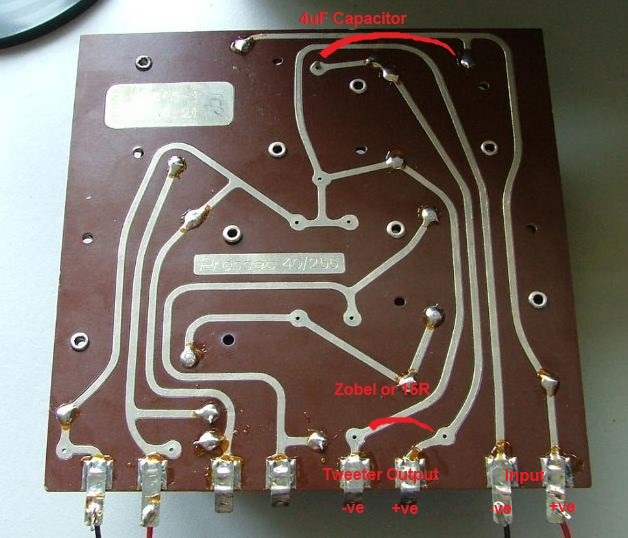
You've got to redo that connection with 6.2R and 4uF in series. You might drill a hole or two in the fibreglass to twist and tie down the ends where the 6.2R and 4uF connect. The zobel or 15R position is trivial to fit.
Wirewound 10 Watt 15 Ohm Resistor | Maplin
5.6R will do if you can't find a 6.2R.
Wirewound 10 Watt 5.6 Ohm Resistor | Maplin

You've got to redo that connection with 6.2R and 4uF in series. You might drill a hole or two in the fibreglass to twist and tie down the ends where the 6.2R and 4uF connect. The zobel or 15R position is trivial to fit.
Wirewound 10 Watt 15 Ohm Resistor | Maplin
5.6R will do if you can't find a 6.2R.
Wirewound 10 Watt 5.6 Ohm Resistor | Maplin
Tough luck: Maplin doesn't deliver abroad!
Will have to find the caps over here: shouldn't be too difficult...
Now waiting for the tweeters to arrive by post.
Will keep you informed anyway.
Thanks again,
Cheers,
Hugh.
Will have to find the caps over here: shouldn't be too difficult...
Now waiting for the tweeters to arrive by post.
Will keep you informed anyway.
Thanks again,
Cheers,
Hugh.
Hi Steve,
Still waiting for my Monacor's to arrive by post.
In the meantime, I bought wirewounds as suggested by you. They look HUGE! Wonder how I will fit them in the limited space left on the board before the 4uF cap connected to the tweeter. Suppose it's important they are connected in serie BEFORE the cap.
Will find a way anyway...
Just got the Super Linton's I told you about: 100% originals and working, including the fried egg type purple tweeters. They look a bit battered though, but this is something I can care about. Will clean and re-polish the veneer and re-oil it. Got very nice results with my other Warfies.
Question: should I recap them and apply the same mods with wirewounds to ease the tweeters?
I heard they were quite fragile and I think mine were replaced in the mid-seventies by new Peerless's.
Thanks for sharing your experience!
Cheers,
Hugh.
PS: My amps are both Marantz, one 2x30W and the other 2x45W RMS.
Hope they're not too powerful for the drivers...
Still waiting for my Monacor's to arrive by post.
In the meantime, I bought wirewounds as suggested by you. They look HUGE! Wonder how I will fit them in the limited space left on the board before the 4uF cap connected to the tweeter. Suppose it's important they are connected in serie BEFORE the cap.
Will find a way anyway...
Just got the Super Linton's I told you about: 100% originals and working, including the fried egg type purple tweeters. They look a bit battered though, but this is something I can care about. Will clean and re-polish the veneer and re-oil it. Got very nice results with my other Warfies.
Question: should I recap them and apply the same mods with wirewounds to ease the tweeters?
I heard they were quite fragile and I think mine were replaced in the mid-seventies by new Peerless's.
Thanks for sharing your experience!
Cheers,
Hugh.
PS: My amps are both Marantz, one 2x30W and the other 2x45W RMS.
Hope they're not too powerful for the drivers...
It's careless use of the volume control that destroys speakers IMO, not the amps rating! There is a notion that big amps are less inclined to clip, which can save damage too. My Amp is 20wpc and I never go full volume on it. But it's loud. It's the nature of an 8" speaker to be efficient.
Components like the resistor and capacitor can be wired in either order. A+B=B+A if you follow. I'd lash it up first to see if the values are right, then trim wires shorter later. It takes an hour or so to adjust to a speaker and start hearing if the balance is right.
IIRC, the polarities go ++- on WMT. So you ought to be finding the tweeter is wired negative polarity at some point. i.e. opposite to the way the other drivers and input are hooked up.
The Fried Egg tweeter was traditionally in the famous American Advent speaker, wasn't it? Just happen top have a picture on the desktop. 🙂
Components like the resistor and capacitor can be wired in either order. A+B=B+A if you follow. I'd lash it up first to see if the values are right, then trim wires shorter later. It takes an hour or so to adjust to a speaker and start hearing if the balance is right.
IIRC, the polarities go ++- on WMT. So you ought to be finding the tweeter is wired negative polarity at some point. i.e. opposite to the way the other drivers and input are hooked up.
The Fried Egg tweeter was traditionally in the famous American Advent speaker, wasn't it? Just happen top have a picture on the desktop. 🙂
Attachments
- Status
- Not open for further replies.
- Home
- Loudspeakers
- Multi-Way
- wharfdale linton 3xp. no mid response. recap?

